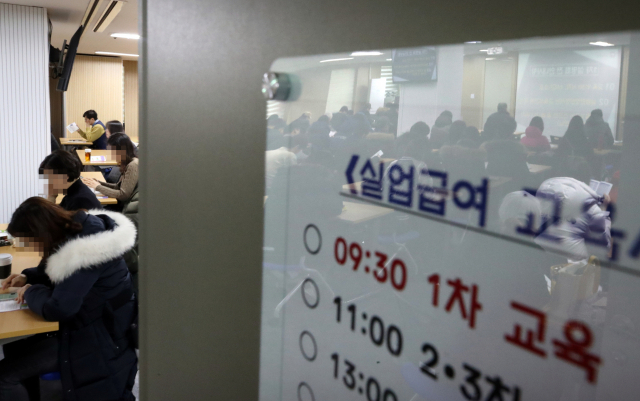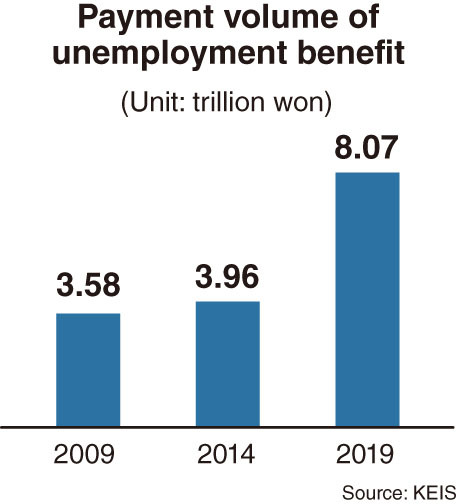 |
Visitors to a regional office of the Korea Employment Information Service in Seoul gather in a classroom in 2019 for a government briefing session on eligibility requirements and the application process for unemployment benefits. (Yonhap) |
SEJONG -- In the early and mid-2010s, the government’s yearly payouts for jobless people ranged between 3.3 trillion won ($2.7 billion) and 4.5 trillion won.
Amid moderate growth in the volume of unemployment benefits, the figure recorded 4.67 trillion won in 2016 during the previous administration, according to the Korea Employment Information Service.
But the situation began to change in 2017 in the aftermath of en masse business closures by self-employed people, who accounted for about 25 percent of all working people and now faced a tight job market.
KEIS data showed that unemployment benefits have continued to increase sharply over the past three years -- reaching 5 trillion won in 2017, 6.43 trillion won in 2018 and an all-time high of 8.07 trillion won in 2019.
The 2019 figure marked a 72.8 percent (or 3.4 trillion won) surge compared with 2016.
Further, compared with five years earlier -- in 2014, when benefits paid out amounted to 3.96 trillion won -- the 2019 payouts constituted a 103.7 percent increase.
 |
(Graphic by Kim Sun-young/The Korea Herald) |
Government officials argue that unemployment benefits payouts rose in proportion to the rise in the statutory minimum wage.
But the rapid growth in payments since the early to mid-2010s could suggest a dire situation in the hiring market during the Moon Jae-in administration.
“Though there were some people who exploited the state-led payout system via shady securing of beneficiary eligibility, data indicated that a growing number of people have been forced to leave their workplaces in the wake of an economic slowdown in recent years,” said an employment research analyst in Seoul.
More recently, the KEIS data showed that the number of recipients has surged among South Koreans engaged in services such as food, lodging and tourism as business owners.
A year earlier, in December 2018, only 642 food retailers were paid unemployment benefits. But the number of recipients climbed rapidly in 2019 -- to 5,272 in July, 6,032 in August, 6,653 in September, 7,656 in October, 8,546 in November and 9,785 in December.
The figure for lodging and tourism shot up to 2,234 in December 2019, compared with only 131 people a year earlier.
Though the KEIS explains that there could be difference in figures between net recipients and redundancy-included recipients, it is evident that the small-restaurant and lodging-tourism sectors represented a sharp contrast from other major jobs.
Market insiders share the view that the spike in the number of recipients in the food and lodging sectors demonstrates that self-employed people face greater difficulty due to drastic hikes in the minimum wage over the past two years.
For full-time salaried workers, the minimum wage climbed from 1.35 million won per month in 2017 to 1.74 million won in 2019.
According to a statement from the Ministry of Employment and Labor, the average recipient of unemployment benefits was paid 1.18 million won a month in 2017. That average monthly payment surged to 1.51 million won in 2019.
Recipients in their 50s accounted for the largest proportion at 26.2 percent, trailed by those in their 60s with 21.3 percent, those in their 40s with 19.4 percent, those in their 30s with 19.2 percent and those in their 20s at 13 percent.
The number of recipients of monthly benefits came to about 420,000 in December 2019.
Among the nation’s 17 major regions (provinces and major cities) nationwide, Gyeonggi Province had the greatest number of people on benefits, 113,000. Seoul was next with 80,400, followed by Busan with 33,500, South Gyeongsang Province with 28,200, Incheon with 27,200 and North Gyeongsang Province with 21,200.
On a yearly basis, the number of recipients totaled 1.45 million throughout last year -- a record high -- as compared with 1.33 million in 2018 and 1.21 million in 2017.
By Kim Yon-se (
kys@heraldcorp.com)





![[Herald Interview] 'Trump will use tariffs as first line of defense for American manufacturing'](http://res.heraldm.com/phpwas/restmb_idxmake.php?idx=644&simg=/content/image/2024/11/26/20241126050017_0.jpg)

![[Health and care] Getting cancer young: Why cancer isn’t just an older person’s battle](http://res.heraldm.com/phpwas/restmb_idxmake.php?idx=644&simg=/content/image/2024/11/26/20241126050043_0.jpg)

